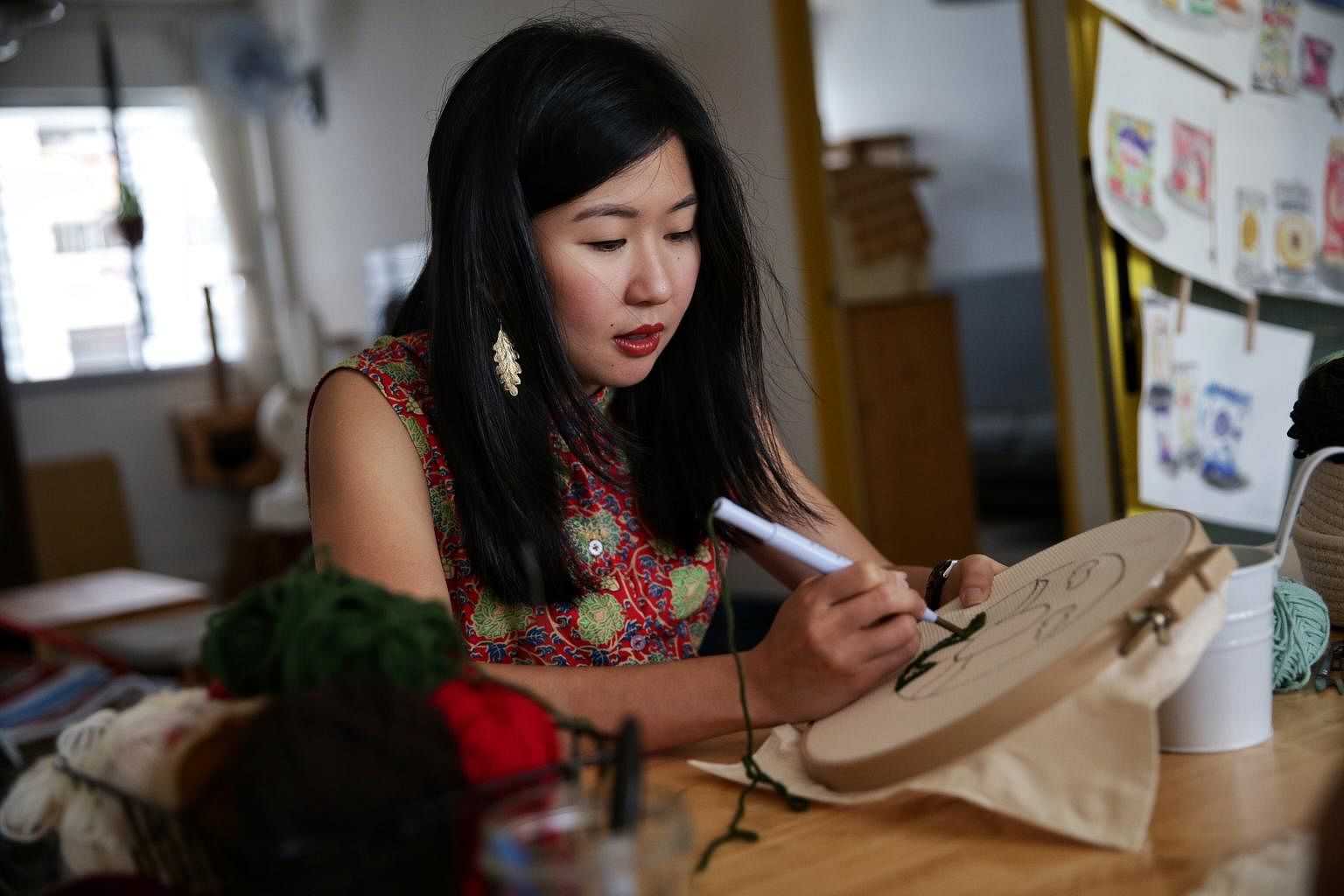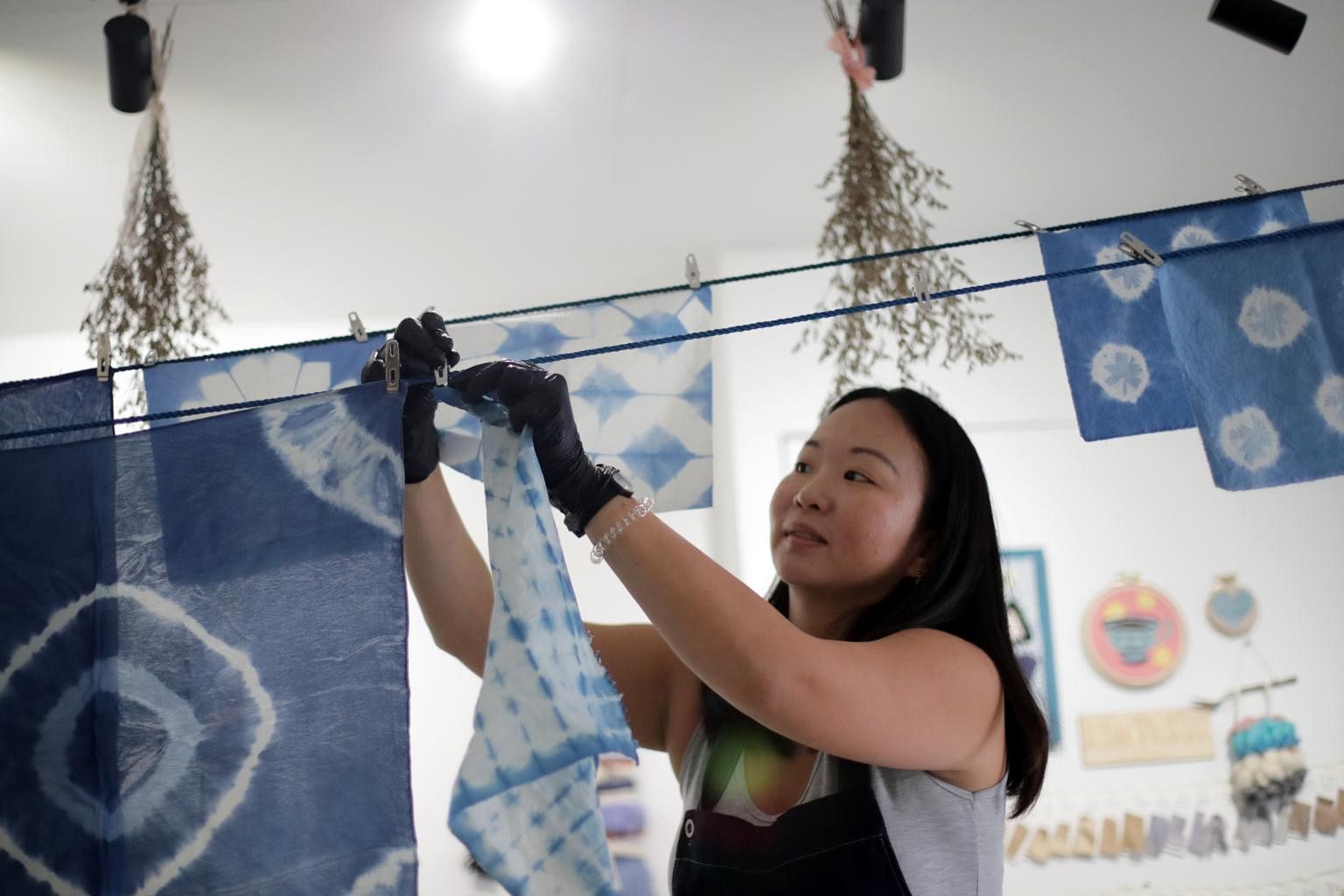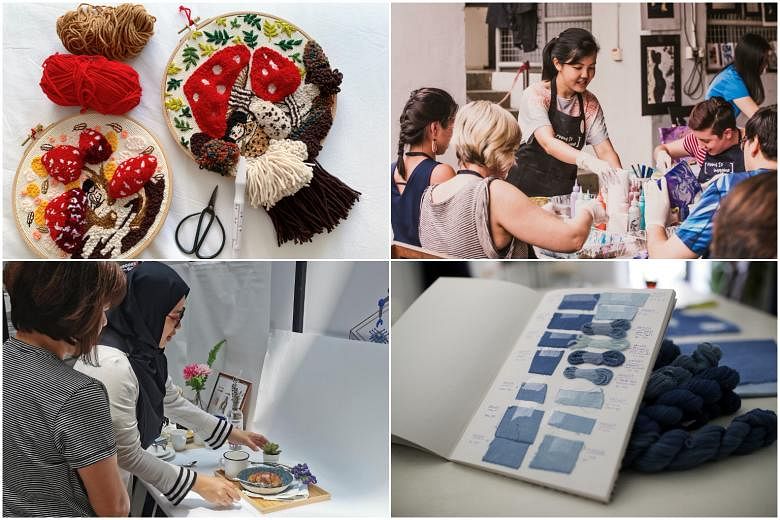SINGAPORE - Years ago, in secondary school, I failed an art exam.
In hindsight, my hastily sketched shipwreck shaded with colour pencils paled in comparison to my classmates' vibrant renditions of marine life.
But the indignity of scoring 45 out of a hundred - on a subject meant to encourage creativity - lingered.
It made me cautious of making missteps when I took part in art workshops recently to emerge from the cloud of stasis that descended after one too many Netflix serials.
In this season of physical distancing and social responsibility, small-group workshops with four to eight participants are a novel alternative to my usual weekend haunts of yoga classes, bars and restaurants.
Crafting promised calm amid the uncertainty of Covid-19, provided I could relinquish my fear of failure.
This proved easier said than done. While pouring resin at a workshop, I fussed over pouring the paint "correctly" and wondered if I had concocted the ideal shade of peach.
"I must warn you, I'm bad at art," I told all the instructors I met. They nodded as though they had heard this dozens of times.
"Singaporeans are generally more afraid of making mistakes," says Ms Ly Yeow, who teaches needle punching workshops at her home studio, Lyttle Space.
She assured me that needle punching is a forgiving medium, which allows a wide berth for experimenting. After a few tries, threading the large-gauge needle came more easily. Tidy rows of yarn appeared on my monkscloth, knolls of green topped with a milky blue sky.
At Ms Yeow's behest, I stopped focusing on my needle placement and let muscle memory take over. My hands fell into a steady rhythm. Had I actually found an art form I am good at?
It takes confidence to learn a new skill, both to begin and to keep at it. With much of the country staying home, there is no better time for self-improvement, either through online or offline classes.
Many of these small-group adult craft classes - for fewer than 10 people - are still going on.
The next time I binge on a new Netflix show, perhaps I will be crafting along with it, and hopefully unravelling a decades-old self-limiting belief with every loop of yarn and punch of needle.
'Draw' with a needle

If you enjoy needlework but lack the patience for knitting or embroidery, needle punching may be the craft for you.
Ms Ly Yeow, a 33-year-old freelance artist and educator, describes it as drawing with a needle.
With colourful yarn and large needles, students can incorporate techniques of embroidery, weaving and pom-pom making to create textured artwork.
Ms Yeow sets a theme for each class to teach different needle punching skills. Students might use pom-pom making techniques to create mushroom caps in a fungi-themed session or create ruffles and loops to depict a seascape.
She runs these classes at Lyttle Space, a home studio in her Bedok South Housing Board flat that she shares with her husband and three cats.
She stumbled upon needle punching about a year ago when her hands began trembling involuntarily, a condition she attributes to overwork. She had previously been working on client-commissioned murals, which was physically taxing as they required her to paint for up to 15 hours a day with one arm elevated.
"I still wanted to do art, so I had to find different ways to express myself," she says. Ms Hannah Foo, 27, an analyst in the finance industry, attended a needle punching workshop earlier this month and found the process therapeutic.
She enjoyed it so much that she purchased a needle punching kit, completed three more pieces on her own and signed up for another embroidery workshop.
"Needle punching lets me forget about my stress for one or two hours and really be immersed in it," she says.
A 31/2-hour needle punching workshop for up to four participants costs $135 a person.
For more information, go to helloiam.me
Pour and swirl to your heart's content

Those who need a morale booster in art should give resin pouring a try, for it almost always guarantees an attractive outcome.
That was what Ms Cindy Neo discovered when a breast cancer diagnosis at 31 made her take a break from her digital marketing job.
She is the founder of Room to Imagine, a studio specialising in acrylic and resin pour art workshops.
The two art forms use slightly different techniques, but both involve pouring paint onto a surface and mixing it for an attractive swirl.
Ms Neo, who holds an animation art degree from Lasalle College of the Arts, wanted to paint again while recuperating and found pour art to be fun and undemanding.
"If I could pick it up easily after not doing art for so long, perhaps people without a strong art background would be able to do the same," says Ms Neo, who is single and now 33.
She started Room to Imagine in 2018, first operating out of her family home, then moving to a shophouse in Jalan Besar last year.
Participants can paint on a canvas or create what Ms Neo calls functional art where they design a coaster, plate, clock or coffee table.
The two-step process starts with adding complementary colours to a resin mixture. Resin is an industrial compound that can be used as an adhesive or for coating floors and tabletops.
They then pour the resin-paint mixture and rotate the canvas to create pearlescent swirls. The mixture cures, or hardens, after 45 minutes.
Participants are mostly working professionals, women in their 20s to 50s, as well as couples looking to create a statement piece for their home. Some have stayed away since the coronavirus hit. Ms Neo conducted eight to 10 workshops in the past month, down from 12 to 15.
But global travel restrictions have drawn new participants searching for things to occupy their weekends.
Bank senior audit manager Alicia Goh, for instance, who is single and declined to give her age,attended a resin art platter workshop, learnt to make burnt cheesecakes at a baking class and took up Korean- language lessons this month. She says: "I usually travel for leisure about once in three months and have been looking for other activities."
Pour art workshops, for up to nine participants at a time, range from $55 for a dish to $150 for a coffee table.
For more information, go to roomtoimagine.sg
Take product pictures that pop

In an Instagram-ready world, an attractive photo can make all the difference as to whether online shoppers click on or scroll past a product.
That is why Ms Liyana Ahmad, 29, founder of graphic design studio Lookeesan Creatives, launched a product styling and photography workshop for social media last month.
The workshop targets home business owners, such as stay-at-home mothers who sell items like baked goods, children's clothes and essential oils.
Ms Athirah Azlan, 29, a freelance digital specialist who assists Ms Liyana in styling workshops, says: "Home business owners may have a good product but don't know how to make it look nice in a photo. We want to help them market their products better."
Ms Liyana, who started the company in 2017 running workshops for design programs Adobe Illustrator, Photoshop and Canva, held the first product styling workshop as part of a public event for the Lifelong Learning Institute in November last year.
Participants, including housewives and grandmothers, asked questions, took photographs of the slides and were keen to try styling a flatlay of their own.
"I realised there were a lot of people who wanted to learn this skill," says Ms Liyana, who operates Lookeesan Creatives out of a shophouse near Arab Street which she shares with her husband's branding agency. Lookeesan is a play on lukisan, the Malay word for drawing.
One does not need fancy props or equipment to take good product photos. Mahjong paper tacked to a wall offers a plain backdrop and everyday items such as glass bottles and patterned tea towels can be upcycled as decor.
Daylight, supplemented with a simple desk light from discount store Miniso, is sufficient for good lighting. And a smartphone, loaded with photo-editing apps, is the only camera you need.
"It is the perfect time for small business owners to learn a new skill and practise it at home, so they will be ready to market their products when the economy picks up," she says.
A four-hour product styling and photography workshop, for up to six participants, costs $188 a person.
For more information, go to lookeesan.com
Try your hand at tie-dyeing

Tie-dyed fabric is often associated with hippie-esque youths, but Mrs Autumn Brown describes her shibori workshops as tie-dyeing for adults.
Shibori is a Japanese dyeing technique that Mrs Brown, 33, teaches at her studio, WithAutumn.
Students use everyday objects to create patterns on a khadi cotton scarf, a type of fabric from India that is handwoven on traditional looms with hand-spun cotton yarn.
Tying marbles into the fabric with rubber bands produces wavy, doughnut-like circles. Clothespins create little squares, while opaque circles clipped to the scarf create polka dots.
The possibilities are endless. Mrs Brown provides templates for nervous learners and two smaller squares of fabric for them to practise on before they dye the actual scarf.
The magic happens when students dip the fabric into a large vat of indigo dye. In a technique known as resist-dyeing, only the exposed parts of the fabric will take on a blue hue, which deepens with multiple soaks.
The dye - warm, organic and metallic-smelling - is made from the leaves of the indigofera plant. Farmers in Indonesia's Flores grow the plant and process its leaves into a paste, which Mrs Brown imports.
At her studio near Ann Siang Hill, she watches over the fermentation process, similar to that of kombucha or cheese.
Like any living thing, the dye must be cared for daily. Mrs Brown feeds it fruit sugars such as banana skins, maintains an alkaline environment and takes dye swatches to check on its "health".
"Indigo is among a huge array of plants that can be used for natural dyeing. It's a great way to learn about the process and get creative," says Mrs Brown, who was born in Singapore and is married to a Briton.
She began running WithAutumn from a co-working space in 2018 and moved to her current premises last year. The studio also offers classes on tapestry weaving, block printing and needle punching.
Although corporate bookings have fallen since the outbreak of Covid-19, sales of her DIY needle punch and weaving kits have remained healthy.
She is currently producing tutorial videos on how to do indigo dyeing at home and will launch a DIY indigo kit in about a month.
She says: "I want to combine the traditional technique of indigo dyeing, which has been used since the eighth century, with modern designs and products that people can incorporate into their everyday lives."
A natural indigo dyeing and shibori workshop, for up to four participants, costs $169 a person.
For more information, go to withautumn.com












